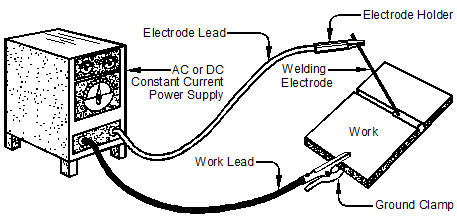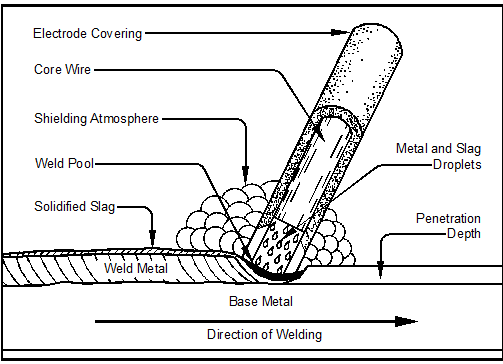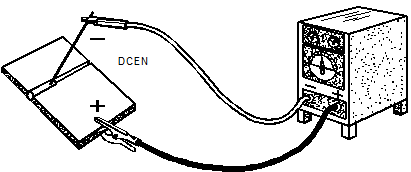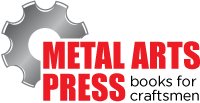- Preface
- Acknowledgements
- Chapter 1: Welding Overview
- Chapter 2: Safety
- Chapter 3: Terms, Joints, & Edge Preparation
- Chapter 4: Tools & Welding Tables
- Chapter 5: Shielded Metal Arc Welding
- Chapter 6: Wire Feed Welding
- Chapter 7: Gas Tungsten Arc Welding
- Chapter 8: Oxyacetylene
- Chapter 9: Controlling Distortion
- Chapter 10: Cutting Processes
- Chapter 11: Brazing & Soldering
- Chapter 12: Common Problems & Solutions
- Chapter 13: Design Tips
- Chapter 14: Fabrication & Repair Tips
- Chapter 15: Tools & Tooling
- Chapter 16: Pipe & Tubing
- Chapter 17: Metallurgy
- Chapter 18: Power Supplies & Electrical Safety
- Chapter 19: Bending & Straightening
- Index
- Credits
Chapter 5
Shielded Metal Arc Welding
The brain that contains the problem probably also contains the solution.
Nancy Kline
Introduction
Shielded metal arc welding, AWS designation SMAW, is also commonly called arc welding, stick welding and stick electrode welding.
Although there had been initial work on arc welding in the 1700s using carbon electrodes powered by batteries, development intensified between 1880 and 1900 when electric generators replaced batteries. By the early 1900s Lincoln Electric offered the first arc welding machine, and by 1912 covered electrodes were patented. Arc welding remains an important process for structural steel and pipeline construction because decision makers in these critical industries choose it for its reliability. Today, arc welding is also popular for industrial, automotive and farm repair because the equipment is relatively inexpensive and can be made portable. Although more welders have learned this process than any other, and its annual filler metal poundage continues to grow, lately it is declining in importance as the wire feed welding processes continue to gain popularity and market share.
During WWII many shipyard workers and servicemen were trained to use shielded metal arc welding. After the war the popularity of low-cost transformer welding power supplies like the Lincoln Electric Company’s “tombstone” enabled these newly trained welders to bring their skills to the farm, the garage, and to factories.
SMAW Equipment
As shown in Figure 5-1, an SMAW outfit requires:
- Constant-current welding power supply.
- Electrode holder, electrode lead and its terminals.
- Ground clamp, work lead and its terminals.
- Welding electrodes.

SMAW Process
SMAW is usually a manual process, but it can be automated. During welding, an electric current flows between the welding power supply, the electrode, the welding arc, the work, the ground clamp, the work lead and back to the welding supply. Electrons flowing through the gap between the electrode and the work produce an arc, or plasma, that furnishes heat to melt both the electrode metal and the workpiece metal.
Because temperatures within the arc exceed 6000ºF, tiny globules of metal form at the tip of the electrode, then transfer to the molten weld pool on the work. As the electrode moves away from the weld pool, the molten mixture of electrode and base metal solidifies, completing the weld.
In the flat or horizontal position, gravity aids electrode metal transfer by gas expansion from the electrode coating materials, electromagnetic forces and surface tension. In other positions, gravity opposes these forces.
The electrode is coated with a flux, and heat from the arc causes this flux coating to burn and decompose. This creates a gaseous shield that protects the electrode tip, the work, and the molten weld pool from atmospheric contamination. The flux contains materials that coat the molten steel droplets as they transfer to the weld and become slag after cooling. This slag floats on the weld pool surface before it solidifies over the weld bead, where it protects the molten metal from exposure to atmosphere and slows the cooling rate. See Figure 5-2.
Some electrode-flux coatings contain metal powder to provide additional metal filler to increase the deposition rate.
The electrode flux and metal electrode determine the chemical, electrical, mechanical and metallurgical properties of the weld as well as the electrode handling characteristics. Only 50% of the heat furnished by the power supply enters the weld; the rest is lost to radiation, the surrounding base metal, and to the weld plume.

Figure 5-2. Shielded metal arc process, also called stick welding.
Applications
SMAW can weld the following metals:
- Aluminum
- Bronze
- Carbon steel
- Cast iron
- Hardfacing alloys
- High-strength steels
- Low-alloy steels
- Malleable iron
- Nickel
- Stainless steel
Some metals require preheat, postheat, or both to prevent weld bead cracking. Since better processes exist, not much aluminum welding is done by SMAW.
SMAW welds from 1/16" to unlimited thicknesses are possible. Thicknesses less than 1/8" can be joined but require much greater skill to prevent the weld from burning through the metal. Thicknesses over 3/4" are more economically welded by other methods such as FCAW, which deposits metal faster.
SMAW Advantages
- Low cost equipment.
- Welds many different metals and alloys, including the most commonly used.
- Relatively portable and can be used in confined spaces.
- With different current settings and rod diameters, the same equipment can weld metals from 1/8" (16 gauge) to metals several feet thick. There is no upper limit on the thickness of metal that can be welded with SMAW.
- Welds can be performed in any position.
- SMAW is less affected by wind and drafts than gas-shielded processes like GMAW and GTAW.
SMAW Disadvantages
- Not suitable for metal sheets under 1/8" thick.
- Operator duty cycle and overall deposition rate are usually lower with SMAW than with wire-fed processes because, with SMAW, welding must be stopped when the electrode is consumed and needs to be replaced.
- Not all of the electrode can be used. The remaining stub in the electrode holder must be discarded, wasting 1–2" of every electrode.
- The frequent stops and starts caused by changing electrodes can result in weld defects.
Weather Restrictions
SMAW is not permitted in rain, snow or blowing sand, and when the base metal is below 0°F. But during these adverse weather conditions, temporary shelters known as dog houses can be erected around the weld site to allow the welding to proceed. Preheating the weld base metal to 70°F with rosebud tips permits welding when the outside temperature is below 0°F.
Welding Power Supplies
SMAW uses constant current welding power supplies because their output characteristics give the welder control over the weld pool size and still limits maximum arc current. The shape of the voltage-versus-current curve indicates that increasing the arc length reduces the welding current—and the size of the weld pool.
Because there is some variation in arc length as the welder moves the electrode along the weldment, the constant current welding power supply insures a stable arc during these variations. For more on constant current power characteristics, see Chapter 18 – Power Supplies & Electrical Safety.
Typical SMAW welding current is 25–600 amperes. With these power supplies the open-circuit voltage—the voltage when no welding is being done and the arc is off—runs from 50–100 volts, but drops to 17–40 volts during welding. The higher the open-circuit voltage, the easier it is to strike an arc, but the greater the risk of electric shock.
AC vs. DC Power Supplies
DC power always provides a more stable arc and more even metal transfer than AC power. Once struck, the DC arc remains continuous. When welding with AC, the arc extinguishes and restrikes 120 times a second as the current and voltage reverse direction. A DC arc has good wetting action of the molten weld metal and uniform weld bead size at low welding currents. For this reason, DC is excellent for welding thin sections. DC is also preferred to AC on overhead and vertical welding jobs because of its shorter arc and dramatically better weld pool control.
When DC welding power supplies are run on three-phase power they provide an even smoother arc than DC welding power supplies run on single-phase power. This is because the three-phase wave forms, when combined by the rectifier, are much smoother—and closer—to pure DC. See Chapter 18 – Power Supplies & Electrical Safety, Figure 18-15 for more details.
Welding Polarities & Characteristics
All three types of polarities are used for SMAW:
- Alternating current (AC).
- Direct current electrode negative (DCEN), also called DCSP for DC-straight polarity, produces less penetration than DCEP but has a higher electrode burn-off rate. See the DCEN set-up in Figure 5-3.

Figure 5-3. DC-Electrode Negative

